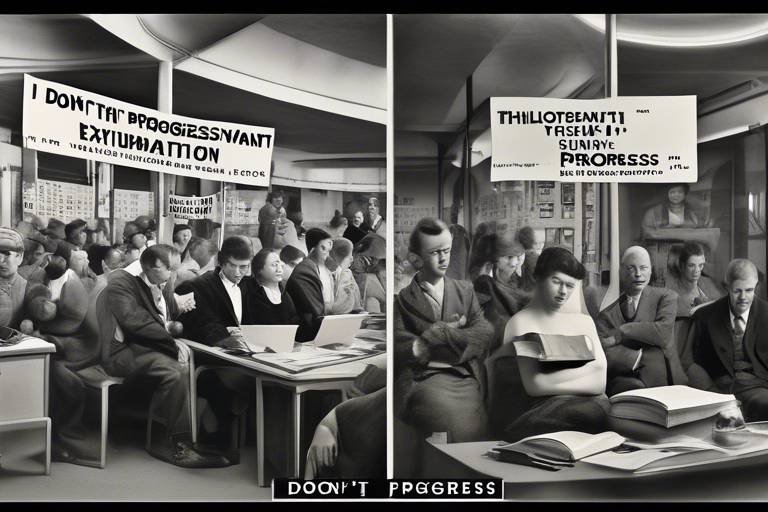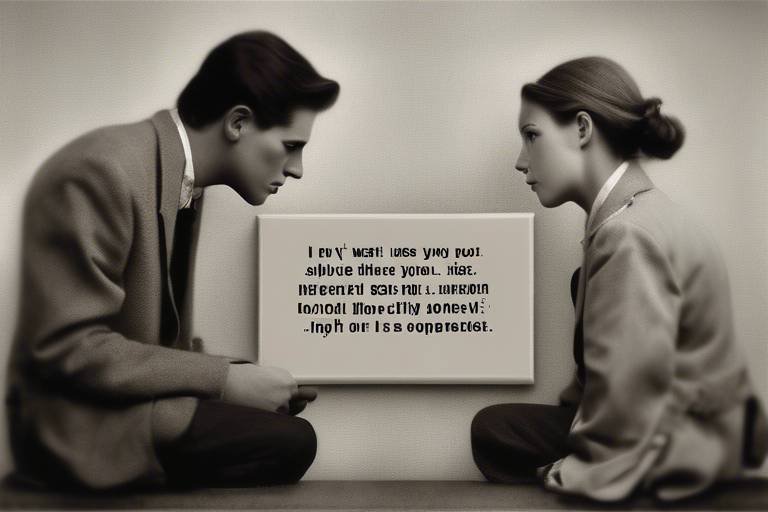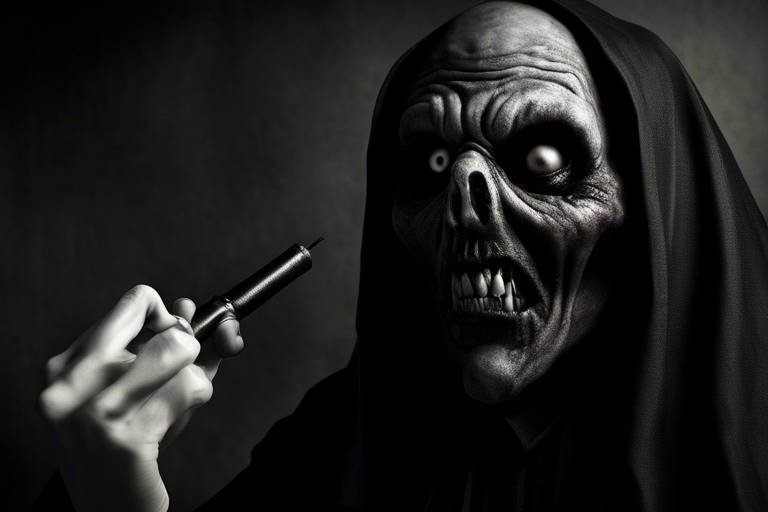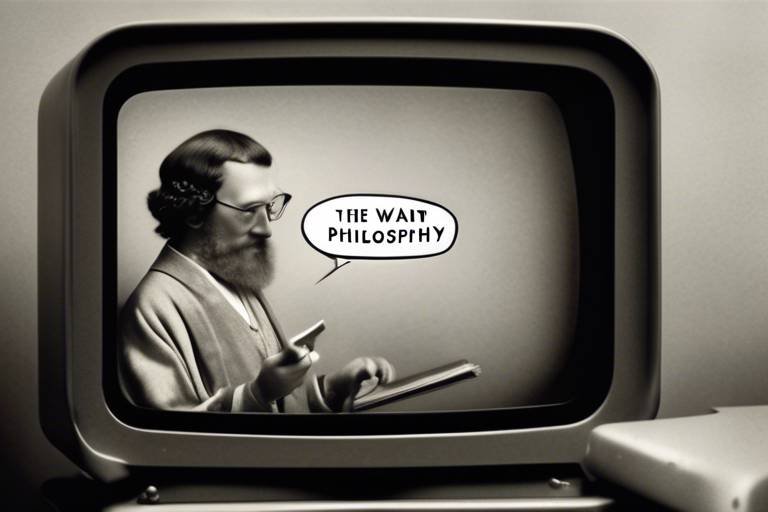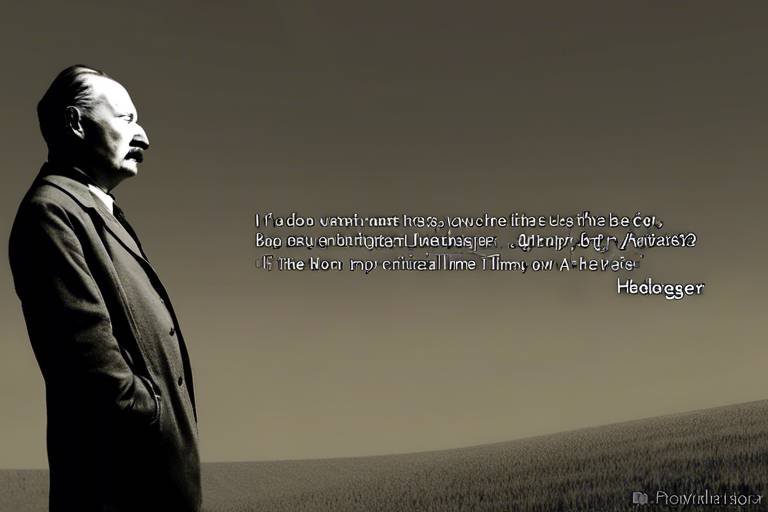Unravelling the Concept of Dread in Existentialism
Existentialism, a philosophical movement that delves into the complexities of human existence, often grapples with the concept of dread. This feeling goes beyond mere fear; it encapsulates a profound sense of anxiety that arises from our awareness of freedom, choice, and the absurdity of life itself. Imagine standing on the edge of a vast abyss, peering into the unknown; that is dread. It is a sensation that can leave us feeling paralyzed, yet it also serves as a powerful impetus for self-exploration and growth.
At its core, dread challenges us to confront the uncomfortable truths about our existence. It forces us to ask the big questions: What does it mean to be free? How do we navigate a world that often seems chaotic and devoid of meaning? These inquiries are not just theoretical; they resonate deeply within our daily lives. When we experience dread, we are confronted with the weight of our choices and the implications they carry. This struggle can be daunting, yet it also opens the door to a more authentic existence.
In the realm of existentialism, dread is not merely a byproduct of our circumstances; it is an essential part of the human experience. As we navigate the complexities of our lives, we often find ourselves wrestling with feelings of inadequacy, uncertainty, and despair. These emotions, while uncomfortable, can lead us to a greater understanding of ourselves and our place in the world. By embracing dread, we can cultivate resilience and develop a deeper sense of purpose.
Throughout history, various philosophers have explored the intricate relationship between dread and existence. Their insights reveal that while dread may feel overwhelming, it can also serve as a catalyst for personal transformation. By acknowledging and confronting our dread, we can unlock new dimensions of our being, allowing us to live more fully and authentically. In this journey, we learn that dread is not just a source of suffering; it can also be a profound teacher.
As we delve deeper into the philosophical underpinnings of dread, we will uncover how key figures such as Kierkegaard, Nietzsche, and Sartre have articulated its significance. Their perspectives shed light on how dread shapes our understanding of freedom, choice, and the quest for meaning in an often absurd world. Through their lenses, we can begin to appreciate dread not as a burden, but as a vital component of our existential journey.
In conclusion, the exploration of dread in existentialism invites us to embrace the complexities of our existence. Rather than shying away from this unsettling emotion, we are encouraged to lean into it, using it as a springboard for self-discovery and authenticity. Dread, in all its forms, is not just a feeling to be feared; it is a profound reminder of our freedom and the choices that define our lives.
- What is dread in existentialism? Dread is a deep-seated anxiety about freedom, choice, and the absurdity of life that is fundamental to the human experience.
- How do existentialist philosophers view dread? Key existentialist thinkers like Kierkegaard, Nietzsche, and Sartre explore dread as a catalyst for personal growth and self-awareness.
- Can dread lead to personal growth? Yes, confronting dread can push individuals to make meaningful choices, fostering authenticity and a deeper understanding of oneself.
- What role does freedom play in dread? Dread emphasizes the weight of our freedom and responsibility, encouraging us to live authentically and purposefully.

The Nature of Dread
Dread is not just a fleeting feeling of apprehension; it is a profound and complex aspect of human existence that digs deep into our psyche. Imagine standing at the edge of a vast abyss, where the weight of your choices looms over you like a dark cloud. This sensation, often described as existential anxiety, emerges from our awareness of freedom and the responsibility that comes with it. When we face the reality that our choices shape our lives, dread becomes an inescapable companion. It's that unsettling feeling that whispers, "What if I choose wrong?" or "What if life is meaningless?"
To grasp the nature of dread, we must first understand its roots in our existential condition. Dread arises from several interconnected sources:
- Freedom: The very essence of being human is our ability to choose. However, with this freedom comes the burden of responsibility, which can be overwhelming.
- Absurdity: Life often presents us with situations that seem irrational or without purpose, leading to feelings of dread as we grapple with the meaning of our existence.
- Isolation: The realization that we are ultimately alone in our experiences can trigger a deep sense of dread, as we confront the limits of our understanding and connection to others.
Understanding dread is crucial for anyone wishing to delve into existentialist thought. It serves as a lens through which we can examine our fears and desires, illuminating the path toward self-discovery. In a world that often feels chaotic and unpredictable, acknowledging dread allows us to confront our deepest anxieties and emerge stronger. It challenges us to ask the hard questions: What do I truly want? What does my existence mean? By engaging with these questions, we can transform dread from a paralyzing force into a catalyst for personal growth.
Ultimately, dread is not merely something to be feared or avoided; it is an invitation to engage with our existence more fully. It pushes us to confront the uncomfortable truths of life, urging us to seek authenticity and purpose in our choices. By embracing this complex emotion, we can navigate the intricacies of human experience with greater clarity and insight.

Existentialist Philosophers and Dread
Dread is not just a fleeting feeling; it is a profound theme that resonates deeply within the realm of existential philosophy. Key thinkers like Kierkegaard, Nietzsche, and Sartre have navigated the turbulent waters of dread, shedding light on its implications for human existence. Each philosopher offers a unique perspective that intertwines dread with the broader questions of freedom, choice, and the search for meaning. Their insights reveal how dread can act as a powerful catalyst for personal growth and self-awareness.
Kierkegaard, often regarded as the father of existentialism, posited that dread arises from the vast expanse of freedom we possess in making choices. He argued that this freedom can be both exhilarating and terrifying, leading individuals to confront the weight of their decisions. In Kierkegaard's view, the act of facing dread is essential for achieving an authentic existence. It is through this confrontation that one can transcend superficial living and engage in a more meaningful exploration of self.
Similarly, Nietzsche explored the theme of dread in the context of the "Übermensch" or "Overman." He believed that the recognition of dread and the absurdity of life could lead to a form of empowerment. Nietzsche's philosophy encourages individuals to embrace their fears and uncertainties, transforming dread into a driving force for creativity and personal evolution. This perspective emphasizes that rather than succumbing to despair, individuals can harness their dread to forge their own paths and define their values.
Sartre, on the other hand, introduced the notion of "nausea," a visceral experience that encapsulates the overwhelming sense of dread when confronted with the absurdity of existence. In his seminal work, Sartre describes how this feeling forces individuals to grapple with their purpose and the inherent meaninglessness of life. The experience of nausea compels one to question their existence and, in doing so, opens the door to authentic living. Sartre's existentialism suggests that by acknowledging and embracing this dread, individuals can reclaim their freedom and responsibility, ultimately leading to a more profound understanding of themselves.
In summary, the exploration of dread by existentialist philosophers serves as a reminder that this unsettling feeling is not merely something to be feared or avoided. Instead, it is a vital aspect of the human experience that can lead to greater self-awareness and authenticity. By engaging with the insights of Kierkegaard, Nietzsche, and Sartre, we can learn to navigate our own feelings of dread, transforming them into opportunities for personal growth and deeper existential understanding.
- What is the relationship between dread and existentialism?
Dread is a central theme in existentialism, representing the anxiety and fear associated with freedom and choice. - How do existentialist philosophers view dread?
Philosophers like Kierkegaard, Nietzsche, and Sartre see dread as a catalyst for personal growth and self-awareness. - Can dread lead to a more authentic life?
Yes, confronting and embracing dread can help individuals recognize their freedom and responsibility, leading to a more authentic existence.

Kierkegaard's Perspective
Søren Kierkegaard, often regarded as the father of existentialism, delves deep into the nature of dread, viewing it as a crucial component of our existence. For Kierkegaard, dread is not merely a feeling to be avoided; it is a profound form of existential anxiety that stems from the burden of choice. Imagine standing at a crossroads, with countless paths before you, each representing a different potential life. The weight of this freedom can be overwhelming, leading to a sense of dread that forces individuals to confront their deepest fears and uncertainties. This confrontation is essential for achieving what Kierkegaard terms "authentic existence."
At the heart of Kierkegaard's philosophy lies the idea that embracing dread is vital for personal growth. He argues that when we face our dread head-on, we begin to understand our true selves. It’s akin to peeling an onion; each layer reveals more about our innermost thoughts and feelings. This process can be uncomfortable and even painful, but it ultimately leads to greater self-awareness and authenticity. Kierkegaard emphasizes that this journey requires courage, as it involves confronting not only our fears but also the reality of our choices and their consequences.
Kierkegaard also intertwines the concept of dread with faith, suggesting that overcoming dread often necessitates a "leap of faith." This leap is not about abandoning reason but rather embracing the uncertainty of life. It’s a recognition that while we may not have all the answers, we can still find meaning in our existence. By taking this leap, individuals can transcend their dread and cultivate a deeper understanding of themselves and their beliefs. In this sense, dread becomes a catalyst for spiritual growth, prompting individuals to seek a more profound connection with their faith and values.
Furthermore, Kierkegaard introduces the idea of despair, which is closely related to dread. Despair arises from the conflict between our current self and our ideal self—the person we aspire to be. This struggle can be daunting, as it often leads to feelings of inadequacy and hopelessness. Kierkegaard posits that acknowledging this despair is essential for personal development. It serves as a wake-up call, urging us to confront our limitations and strive for a more authentic existence. In essence, dread and despair are intertwined; they reflect the complexities of the human experience and the ongoing quest for meaning.
In summary, Kierkegaard's perspective on dread reveals its multifaceted nature. It is not simply a negative emotion to be cast aside; rather, it is a vital part of our journey toward authenticity and self-discovery. By embracing dread, we can confront our fears, make meaningful choices, and ultimately live a more fulfilling life. This approach challenges us to rethink our relationship with dread, transforming it from a source of anxiety into a powerful catalyst for personal and spiritual growth.

Fear and Faith
In the intricate tapestry of Kierkegaard's philosophy, dread is not merely an emotion to be swept under the rug; rather, it is a profound catalyst that intertwines with the concept of faith. Imagine standing at the edge of a vast, uncharted ocean, the waves crashing against the shore, each one a reminder of the unknown that lies ahead. This is akin to the experience of dread, where the fear of the unknown meets the leap of faith required to navigate the complexities of existence. Kierkegaard posits that to truly understand oneself, one must confront this dread head-on. It is through this confrontation that individuals can transcend their fears and embark on a journey toward authentic existence.
But what does it mean to leap into faith amidst dread? To Kierkegaard, faith is not a blind belief; it is a conscious decision to embrace uncertainty. It's akin to stepping into the dark, trusting that there is a solid ground beneath your feet, even when you can't see it. This leap involves recognizing that dread is a natural part of the human experience, a signal that we are grappling with our freedom and the weight of our choices. As we face our fears, we begin to unravel the layers of our existence, discovering the essence of who we truly are.
Moreover, Kierkegaard's exploration of faith suggests that overcoming dread is not simply about finding comfort; it is about engaging in a transformative process. Individuals must confront their deepest fears, which often manifest as doubts about their beliefs and values. This struggle is not a sign of weakness but rather an essential part of the journey toward self-awareness. In this light, dread becomes a necessary companion on the path to faith, prompting us to question our assumptions and seek a deeper understanding of our place in the world.
Thus, the relationship between fear and faith is a dynamic interplay, where each element informs and shapes the other. As individuals embrace their dread, they cultivate a stronger sense of faith—faith not only in a higher power but also in themselves. This duality highlights the beauty of the human experience: that through fear, we can find strength, and through faith, we can conquer our dread. It's a paradox that invites us to lean into our vulnerabilities, ultimately leading to a richer and more meaningful existence.

The Concept of Despair
Despair is a profound and intricate concept that resonates deeply within the framework of existentialism, particularly in the works of Søren Kierkegaard. It is not merely a fleeting emotion; rather, it embodies a fundamental struggle that individuals face when they grapple with their own existence and the ideals they aspire to achieve. Kierkegaard posits that despair arises when there is a dissonance between the self that one is and the self that one wishes to be. This internal conflict can lead to feelings of inadequacy, frustration, and a sense of being trapped in a life that feels unfulfilling.
At its core, despair can be understood as a confrontation with the limitations of human existence. It forces individuals to confront their own mortality, the inevitability of failure, and the often harsh realities of life. Kierkegaard categorizes despair into different forms, which can be summarized as follows:
| Type of Despair | Description |
|---|---|
| Despair of Finitude | This occurs when individuals are overwhelmed by the limitations of their existence, feeling trapped by their circumstances. |
| Despair of Infinitude | This type arises when individuals are unable to commit to any particular choice, feeling lost in an infinite array of possibilities. |
| Despair of the Ideal | This form reflects the struggle between the actual self and the ideal self, leading to a profound sense of inadequacy. |
Moreover, Kierkegaard emphasizes that despair is not an end in itself but rather a critical phase in the journey toward self-realization. He argues that acknowledging and confronting despair is essential for personal growth. By facing this existential crisis head-on, individuals can gain clarity about their true desires and aspirations. This process of confrontation can be likened to peeling away the layers of an onion; each layer represents a false self or societal expectation that must be shed to reveal the authentic self beneath.
Ultimately, the concept of despair invites individuals to embark on a journey of self-discovery. It challenges them to reflect on their life choices and the authenticity of their existence. In this way, despair serves as a catalyst for transformation, urging individuals to strive for a more genuine and fulfilling life. By embracing their despair, individuals can transcend it, paving the way for a deeper understanding of themselves and their place in the world.
- What is the relationship between dread and despair in existentialism?
Both dread and despair are central to existentialist thought, representing different aspects of human anxiety and the struggle for authenticity. Dread often leads to despair when individuals confront the limitations of their existence. - How can one overcome despair?
Overcoming despair involves confronting one's feelings, acknowledging the dissonance between the actual and ideal self, and engaging in a journey of self-discovery and acceptance. - Is despair a necessary part of personal growth?
Yes, many existentialist philosophers argue that experiencing despair can be a crucial step toward achieving authenticity and a deeper understanding of oneself.

Sartre's Notion of Nausea
Sartre's concept of nausea is a profound exploration of the human condition, encapsulating the overwhelming sensation that arises when one confronts the absurdity of existence. Imagine standing on the edge of a cliff, gazing into an abyss; that gut-wrenching feeling is akin to the nausea Sartre describes. It’s not just a physical sensation but a deep existential realization that life may lack inherent meaning. This feeling can be unsettling, almost like a cruel joke played by the universe, prompting us to question everything we thought we knew about ourselves and our purpose.
In his seminal work, "Nausea," Sartre illustrates how this experience can lead to a profound sense of disorientation and confusion. The protagonist, Antoine Roquentin, grapples with the absurdity of his existence, feeling a disconnect between his thoughts and the world around him. This disconnect manifests as a visceral reaction, a physical nausea that symbolizes the existential struggle we all face. Sartre uses this metaphor to emphasize that, in the face of a chaotic and indifferent universe, individuals are often left feeling lost and bewildered.
But what does this nausea truly signify? At its core, it reflects a confrontation with the freedom that comes with existence. Sartre argues that with freedom comes responsibility, and this can be a heavy burden to bear. The nausea serves as a reminder that we are not merely products of our environment or circumstances; rather, we possess the ability to choose our paths, even in a world that seems devoid of meaning. This realization can be both liberating and terrifying, as it forces us to confront our own agency.
Interestingly, Sartre posits that this feeling of nausea can also act as a catalyst for self-discovery. By embracing the discomfort that comes with this existential awareness, individuals can begin to peel back the layers of their identity. They can question societal norms, personal beliefs, and the roles they play in life. In this sense, nausea becomes a transformative experience, pushing individuals to seek authenticity in their existence.
To summarize, Sartre's notion of nausea is not merely about feeling unwell; it is a profound commentary on the human experience. It challenges us to confront the absurdity of life and our place within it. Here are some key takeaways:
- Nausea represents existential anxiety—a visceral reaction to the absurdity of life.
- It highlights the burden of freedom—with the ability to choose comes the weight of responsibility.
- Embracing nausea can lead to self-discovery—encouraging individuals to seek authenticity and meaning.
In conclusion, Sartre's exploration of nausea invites us to engage with our existence more deeply. Rather than shying away from the discomfort it brings, we should embrace it as a powerful tool for personal growth and understanding. After all, in the chaos of life, finding our own meaning is the ultimate act of defiance against the absurd.
- What is the main idea behind Sartre's notion of nausea?
Nausea reflects the existential anxiety that arises when one confronts the absurdity of existence, leading to a deeper understanding of freedom and personal agency. - How does nausea relate to existentialism?
Nausea is a central theme in existentialism, emphasizing the struggle for authenticity and the responsibility that comes with freedom. - Can nausea be a positive experience?
Yes, while it may be uncomfortable, nausea can serve as a catalyst for self-discovery and personal growth.

Dread as a Catalyst for Authenticity
Dread is not just an emotion we experience; it serves as a profound catalyst for authenticity in our lives. Imagine standing at the edge of a cliff, the wind whipping around you, and the vastness of the world stretching out below. That feeling of dread, that knot in your stomach, is a reminder of your freedom to leap—or not. In this way, dread compels us to confront our fears and choices, pushing us to seek out what is genuinely meaningful in our existence. It’s like a spotlight shining on our innermost selves, revealing the truths we often hide from ourselves.
When we embrace dread, we begin to understand the weight of our choices. Each decision we make carries the potential for both joy and pain, and this duality can be overwhelming. However, it is through this struggle that we discover our true selves. By facing our dread head-on, we can peel away the layers of societal expectations and superficial desires, ultimately revealing what we truly want from life. This journey can be likened to chiseling away at a block of marble; with each strike, the authentic form emerges from the stone.
Moreover, dread encourages us to take ownership of our lives. It reminds us that we are not mere passengers in the journey of existence but active participants. This realization is liberating! When we acknowledge our dread, we also recognize our freedom and responsibility. It’s a powerful motivator that can lead to significant personal growth. As we confront our fears, we learn to make choices that align with our values and desires, rather than those imposed by others.
In essence, dread can be a transformative experience, guiding us toward a more authentic existence. It challenges us to ask critical questions like:
- What do I truly value?
- Am I living my life for myself or for others?
- What fears are holding me back from pursuing my dreams?
By wrestling with these questions, we can cultivate a deeper understanding of ourselves and our place in the world. Dread, therefore, is not merely an obstacle to be overcome but a crucial part of the journey toward authenticity. It shapes our experiences and ultimately helps us to create a life that resonates with our true selves.
In conclusion, embracing dread can lead us to a life filled with purpose and authenticity. It’s a reminder that while life may be fraught with uncertainty, it’s also brimming with possibilities. So, the next time you feel that familiar sense of dread creeping in, consider it an invitation to explore the depths of your existence and emerge more authentically you.
- What is the relationship between dread and authenticity?
Dread can serve as a catalyst for authenticity by pushing individuals to confront their fears and make choices that align with their true selves. - How can I embrace dread in my life?
To embrace dread, acknowledge your fears, reflect on your values, and make decisions that resonate with who you truly are. - Is dread a negative emotion?
While dread can feel uncomfortable, it is not inherently negative. It can lead to personal growth and a deeper understanding of oneself.

Embracing Freedom
Embracing freedom is like stepping into a vast, uncharted ocean where the waves of choice can either thrill you or terrify you. When we talk about freedom in the context of dread, it's essential to recognize that this freedom comes with a hefty dose of responsibility. The moment we acknowledge our ability to make choices, we also become aware of the weight those choices carry. It’s almost like being handed the keys to a car without a map—exciting yet daunting at the same time. This realization can provoke a sense of dread, as we confront the infinite possibilities and the potential consequences of our decisions.
However, rather than shying away from this dread, embracing it can lead to profound personal growth. It forces us to engage in self-reflection and to ask ourselves tough questions: What do I truly want?, What am I willing to sacrifice?, and How do my choices align with my values? By grappling with these questions, we can transform dread into a powerful motivator that propels us toward authenticity.
For instance, when faced with a significant life choice—like changing careers or ending a relationship—the dread we feel can serve as a catalyst for deeper introspection. Instead of succumbing to paralysis by analysis, we can view this dread as an invitation to explore our true desires and aspirations. This exploration can lead us to make choices that resonate with our authentic selves, paving the way for a more fulfilling existence. In essence, embracing freedom means accepting the responsibility that comes with it, and in doing so, we can cultivate a life that reflects who we truly are.
Moreover, confronting our dread allows us to recognize that our freedom is not just about making choices; it’s also about owning the consequences of those choices. This ownership is crucial because it empowers us to learn from our experiences, whether they lead to success or failure. By viewing our decisions as opportunities for growth rather than as burdens, we can shift our perspective and embrace the journey of self-discovery that comes with living authentically.
To illustrate this concept further, consider the following table that outlines the relationship between dread, freedom, and authenticity:
| Dread | Freedom | Authenticity |
|---|---|---|
| Facilitates self-reflection | Enables choice-making | Encourages true self-expression |
| Prompts questioning of beliefs | Requires responsibility | Leads to fulfillment |
| Acts as a catalyst for change | Opens up possibilities | Fosters genuine relationships |
In conclusion, embracing freedom is not merely about reveling in the absence of constraints; it’s about engaging with the complexities of choice and the dread that accompanies it. By leaning into this dread, we can unlock a deeper understanding of ourselves and our place in the world. So, the next time you feel that familiar pang of anxiety when faced with a decision, remember that it’s not just fear—it’s a powerful reminder of your freedom and the incredible potential that lies within you.
- What is the relationship between dread and freedom? Dread highlights the weight of our choices, making us aware of our freedom and the responsibilities that come with it.
- How can I embrace my freedom? Start by acknowledging your choices and the potential consequences, then engage in self-reflection to align your decisions with your authentic self.
- Why is dread important in the journey to authenticity? Dread serves as a catalyst for introspection, prompting us to question our beliefs and desires, which is essential for living authentically.

Confronting Absurdity
When we talk about , we're diving into a profound and often unsettling aspect of the human experience. Life can sometimes feel like a chaotic jumble of events that lack clear meaning or purpose. Imagine standing in the middle of a carnival, surrounded by laughter and music, yet feeling a deep sense of emptiness. This is the essence of absurdity. It's that nagging feeling that despite the vibrant tapestry of life, something crucial is missing. But here's the twist: confronting this absurdity can be liberating. Instead of shying away from it, we can embrace it and use it as a springboard for personal growth.
Existentialist thinkers, particularly Sartre, have emphasized that acknowledging the absurdity of our existence is the first step towards true freedom. It’s like peeling back the layers of an onion; each layer reveals more about our reality, but it also brings tears. When we strip away the comforting illusions we often cling to, we can start to see life for what it truly is—a series of choices we must make amidst uncertainty. This realization can be daunting, yet it offers a unique opportunity to create our own meaning in a world that seems indifferent.
To illustrate this, consider the following table that outlines how confronting absurdity can lead to personal transformation:
| Aspect | Confronting Absurdity | Outcome |
|---|---|---|
| Awareness | Recognizing the lack of inherent meaning | Increased self-awareness and clarity |
| Choice | Realizing the freedom to choose | Empowerment and responsibility |
| Meaning | Creating personal meaning | Fulfillment and authenticity |
By facing the absurd, we learn to navigate our lives with a sense of purpose that is self-defined rather than imposed by external standards. This journey often involves grappling with questions that can feel overwhelming. What do I truly value? What kind of life do I want to lead? These inquiries can act as a compass, guiding us through the fog of uncertainty. As we confront absurdity, we may also find ourselves drawn to the things that genuinely matter to us—our passions, relationships, and dreams. It's a process of distilling the essence of our existence, much like a sculptor chiseling away at a block of marble to reveal the masterpiece within.
Ultimately, confronting absurdity is not just about recognizing the chaos of life; it's about embracing it. It’s about understanding that while we may not have all the answers, we have the power to ask the right questions and forge our own path. The absurdity of existence can be a source of dread, but it can also be a wellspring of creativity and resilience. So, the next time you find yourself feeling lost in the absurd, remember: it’s not just a struggle; it’s an invitation to explore, to create, and to live authentically.
- What is existentialism? Existentialism is a philosophical movement that emphasizes individual existence, freedom, and choice, often exploring themes of absurdity and meaning.
- How does dread relate to existentialism? Dread is a fundamental aspect of existentialism, representing the anxiety and fear that arise from the realization of our freedom and the absurdity of life.
- Can confronting absurdity lead to happiness? Yes, by confronting absurdity, individuals can find personal meaning and purpose, leading to a more authentic and fulfilling life.
- Who are the key existentialist philosophers? Key figures include Søren Kierkegaard, Friedrich Nietzsche, and Jean-Paul Sartre, each offering unique insights into the nature of existence and dread.
Frequently Asked Questions
- What is dread in the context of existentialism?
Dread, in existentialism, is a profound sense of anxiety that emerges from the awareness of our freedom and the choices we face. It reflects our struggle with the absurdity of life and the weight of responsibility that comes with making choices.
- How do existentialist philosophers view dread?
Existentialist thinkers like Kierkegaard, Nietzsche, and Sartre explore dread as a crucial element of the human experience. They suggest that facing dread can lead to personal growth, self-awareness, and a more authentic existence.
- What role does Kierkegaard play in understanding dread?
Kierkegaard sees dread as existential anxiety tied to the freedom of choice. He emphasizes that confronting this dread is essential for achieving an authentic life, suggesting that a leap of faith can help individuals overcome their fears.
- How is dread related to despair in Kierkegaard's philosophy?
Dread and despair are closely linked in Kierkegaard's work. Despair arises from the conflict between our actual self and our ideal self, with dread highlighting this existential struggle. Understanding this relationship is key to navigating one's existence.
- What is Sartre's concept of nausea?
Sartre's notion of nausea captures the overwhelming feeling of dread when confronting life's absurdity. This experience compels individuals to question their purpose and the meaning of existence, prompting a deeper exploration of their beliefs.
- Can dread lead to a more authentic life?
Absolutely! Embracing dread can serve as a catalyst for authenticity. By facing their fears, individuals can recognize their freedom and responsibility, ultimately leading to more meaningful choices and a purposeful life.
- How does confronting absurdity relate to personal development?
Confronting the absurdity of life through dread encourages individuals to seek their own meaning. This journey of self-discovery is essential for personal development and achieving existential fulfillment.



